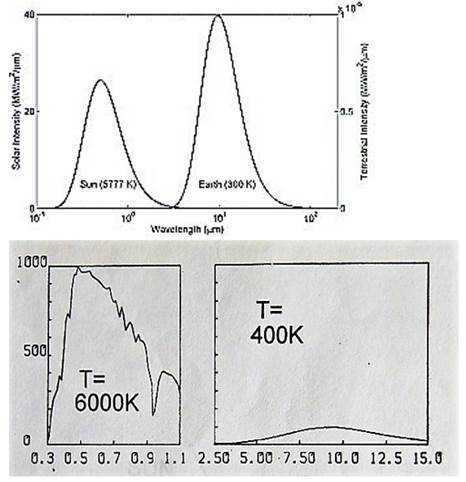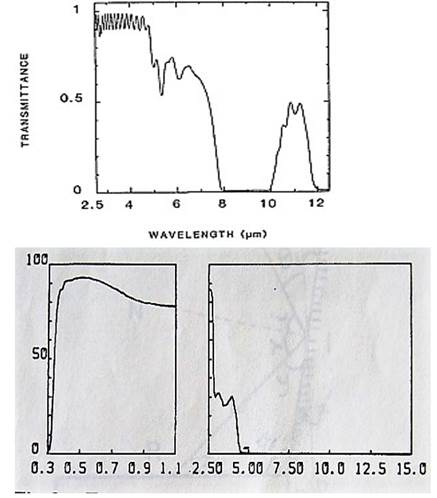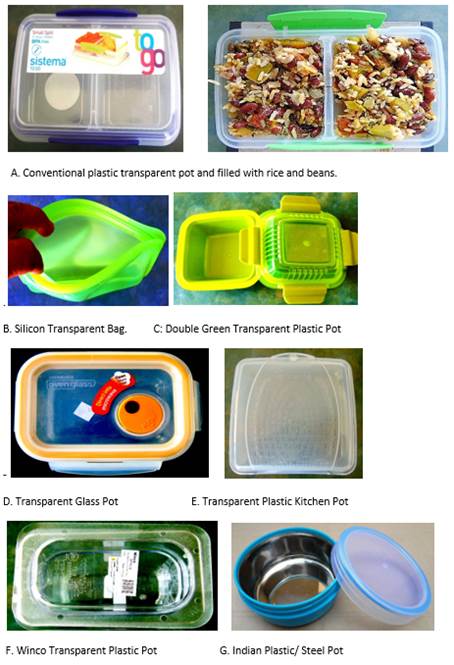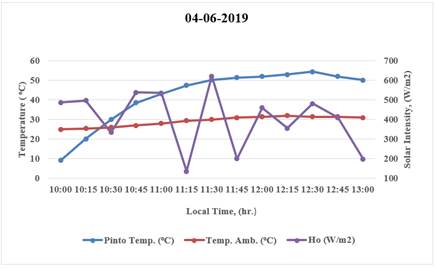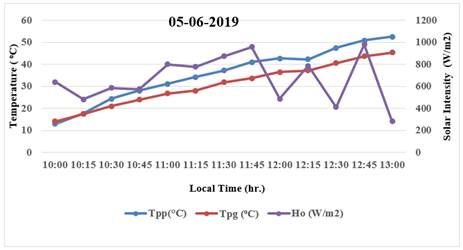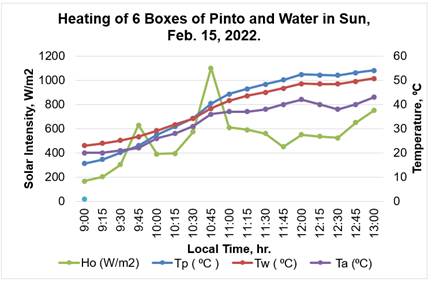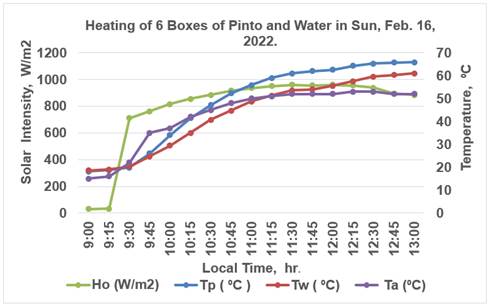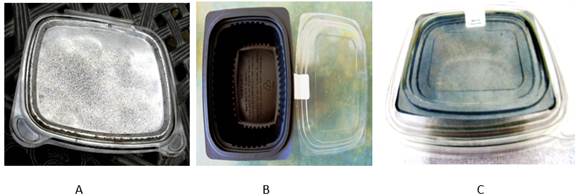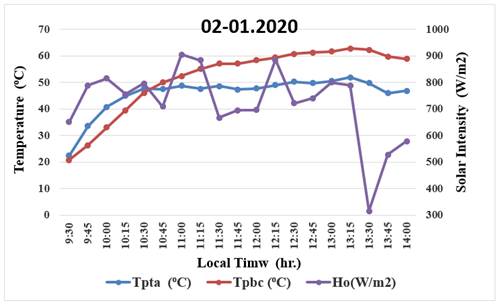|
|
|
|
USE OF GREENHOUSE EFFECT TO HEAT MEAL AT LOWER COST USING SOLAR ENERGY1 Retired Professor, Universidad Nacional, Heredia, Costa Rica, Independent Researcher, User and Promotor of Solar Energy. Costa Rica (Central America) |
|
||
|
|
|||
|
Received 22 January 2022 Accepted 26 February 2022 Published 14 March 2022 Corresponding Author Shyam S. Nandwani, snandwan@yahoo.com DOI 10.29121/ijetmr.v9.i3.2022.1128 Funding: This research
received no specific grant from any funding agency in the public, commercial,
or not-for-profit sectors. Copyright: © 2022 The
Author(s). This is an open access article distributed under the terms of the
Creative Commons Attribution License, which permits unrestricted use, distribution,
and reproduction in any medium, provided the original author and source are
credited.
|
ABSTRACT |
|
|
|
Warming meal at educational centers for students is
done with microwave ovens consuming high energy. Conventional hot box solar
ovens can warm meal using free, abundant, and clean Solar energy, during most
of the time in many places in Costa Rica. For the rest of the periods,
Microwave Ovens, can be used if required. In order to
reduce the cost of heating meal, no solar ovens are used, and the lunch box
with meal is just kept in Sun. Different conventional and disposable pots are
studied which can be used also in Microwave ovens. Due to pandemic period
experiments have been done at authors house for measuring oven, meal
temperature with solar radiation and with different pots. The results are
encouraging After two years of COVID, this year the classes are planned in
live and again the real heating of lunch will be done. We plan to promote the
concept and see the acceptance by the students. |
|
||
|
Keywords: Solar Energy, Warming Meal, Microwave Meal
Warming, Normal Pots, Disposable Pots 1. INTRODUCTION
In the previous works, Nandwani (2021), Nandwani (2022), Nandwani (1979), have mentioned the use of free, clean, and abundant
Energy coming from SUN, for cooking, warming meal, pasteurizing water and
more uses at home and educational centers. One big metallic solar oven (100
cm X 60 cm), with durability of more than 10 years for heating 40-50 lunch
boxes simultaneously in 2-3 hours can cost about US$300-350. Although the
initial cost can be recovered in 3-5 years with saving of electricity and
depending on uses, still many primary and secondary schools (colleges)
consider this price expensive. Only about 40-45 colleges have installed about
90 solar ovens, without any government subsidies.
Possible reasons could be lack of space, playground nearby, adverse
effect due to wind, especially in summer and more important could be
comparatively high initial cost of Solar Oven, by many institutions.
First two limitations can be solved in some cases finding another
place for keeping solar ovens or for playground. In the present work we will
mention some alternatives to reduce the cost for warming lunch, and thus
reduce electric consumption for the institution. Before we use solar or
electrical energy for warming lunch at office or educational institutes, it
is highly recommended the use of good thermal bag for carrying lunch box to
the work/study place, in order to reduce the heat
energy loss from lunch box. |
|
||
We will be talking basically cost limitation which is the main objective of this paper.
2. REDUCTION OF COST
The reason for comparatively high cost may be as there are no full-time sellers, some make on demand and in very low numbers. The other options for cost reduction for heating meal could be:
Wooden or Cardboard oven,
Portable and personalized solar oven,
heating in pots with solar energy but without solar oven.
We Will Inform the First Two Aspects in Brief, But Third Aspect in Some Detail
2.1. Wooden or Cardboard oven
One can make cheaper solar oven, made of either wood or carboard box (Figure 1). Although the thermal performance can be similar to metal however during rainy period (not very common but unpredictable) these ovens can get spoil. Also due to medium wind, the cardboard oven may fall. Thus, these may not be recommended in educational institutes, except if proper care is taken, like covering the ovens with some thick cover or moved to other covered place.
|
|
|
Figure 1 Cheaper Ovens, Wooden (left)
and Cardboard (Right) |
2.2. PORTABLE AND PERSONALIZED SOLAR OVEN
Instead of one big solar oven for 40-50 students/lunch boxes, one can think of portable personal solar oven for each student. External dimension could be approximately 27 cmX20 cmX13 cm (Figure 2). It could be of wood, metal, or plastic. Because of the smaller size it could be made either at educational center or by students itself and will be cheaper. In addition, being portable the name of the owner can be written on the solar oven, as some students write their name on their lunch box. These portable ovens can be kept in schools/colleges and the students can bring only the lunch box.
|
|
|
Figure 2 Portable Wooden (left) and
Plastic (right) Solar Oven |
2.3. HEATING IN POTS WITH SOLAR ENERGY BUT WITHOUT SOLAR OVEN
Another option and cheap way to heat lunch, could be with the use of solar energy but without expensive Solar Oven. The concept is same as of notorious global warming caused by greenhouse effect (Figure 3). Just keep the lunch box in the sun.
|
|
|
Figure 3 Concept- Heating of meal
without Solar Oven |
The greenhouse effect is
the way in which heat is trapped close to Earth's surface by “greenhouse
gases.” These are carbon dioxide (mainly), methane, nitrous oxides, and water
vapor. Greenhouse gases occur naturally
and are part of our atmosphere's makeup, keeps the planet at a friendly
15 °C on average. But in the last century or so, humans have been
interfering with the planet's energy balance, mainly through the burning of
fossil fuels that add carbon dioxide to the air. The level of carbon dioxide in
Earth’s atmosphere has been rising consistently for decades (approximately 310
ppm in 1960 to 412 ppm now) and traps extra heat near Earth's surface, causing earth
temperature to rise.
Figure 4 shows the emission spectrum of a blackbody with wavelength (µm).and Figure 5 a shows Transmission spectrum of carbon dioxide with wavelength. We can see that the low wavelength solar radiation from high temperature sun (6000 K) can pass through Carbon Dioxide, however high wavelength (infrared) radiation from low temperature earth planet (300-400 K) cannot pass through Carbon dioxide gases. Nandwani (2001), thus creating global warming.
|
|
|
Figure 4 Emission Spectrum of a
blackbody with wavelength (µm) |
|
|
|
Figure 5 Transmission spectrum of carbon
dioxide (left) and and common transparent glass
(right) with wavelength (µm) |
Fortunately, transmission spectrum of Carbon Dioxide (Figure 5a) is similar to transparent glass (Figure 5b) and even plastic. First part coming from Sun, whereas second
part emitted by earth planet including lunch box.
Thus, we can use the negative consequence of global warming due to Carbon Dioxide to heat lunch using transparent glass or plastic,
We did experiments with different transparent plastic pots bought as well as free transparent plastic boxes coming with different eatable stuffs. Some of the results are mentioned here.
3. CONVENTIONAL TRANSPARENT PLASTIC POTS
Figure 6 show some transparent pots bought at different places and at different times which can be used also in microwave ovens and satisfy other conditions like convenient size and weight for the students etc. Here it is not necessary that it should resist high temperature as is required in solar oven, Nandwani (2022). Pot G, bought recently in India, although has stainless steel inside, but can also be used in Microwave oven, claimed by manufacturer and checked by author.
|
|
|
Figure 6 Different types of pots studied
for warming lunch, using Solar energy |
All the pots are studied for warming pinto (one of the typical Costa Rican dish, rice, beans, and spices etc.). In all the cases, pot with 250g of cooked pinto was taken from the refrigerator (15-20 ⁰C) and put in the sun for warming. Experiments have been performed during June 3, 4, 5, 9, July 2, 5, 10, 13, Oct. 28, Nov. 26, Dec. 2, 15, 25, 2019. However, we will inform detailed results only for two pots commonly available, transparent plastic (A) and glass pots (D), for few days. For other pots we will just give final results. Temperature of pinto, ambient and solar radiation was measured every 30 min.
1) POT A, Conventional Plastic pot. Experiments were done on June 3 and June 4, 2019. We will just give result for June 4, 2019. Weight of empty plastic pot is 100g. Experiment was performed during 10:00 to 13:00. Results are shown in Figure 7. At 12 md (normal lunch time) the pinto temperature was 52.1 °C, sufficient hot to enjoy lunch. Results for June 3, 2019 was similar.
|
|
|
Figure 7 Variation of pinto and ambient
temperature with solar radiation in pot A |
4. POTS A AND D. CONVENTIONAL PLASTIC AND TRANSPARENT GLASS POT
Same 250g of pinto was kept in plastic pot (total weight 350g) and in glass pot (total weight 366g). Experiment was done on June 5, 2019, during 10 to 13 hrs. Results are shown in Figure 8.
|
|
|
Figure 8 Variation of pinto temperature
with solar radiation in conventional plastic (A) and Glass (D) pot |
Maximum temperature of pinto was attained 52.5 ⁰C in plastic (Tpp) and 45.5 ⁰C (Tpg) in glass pot respectively in 3 hours.
Same experiment was repeated on June 9, 2019. The day was sunny. The pinto temperature reached to 52.1 ⁰C in plastic pot and 46.5 ⁰C in glass pot at 11:15 am. In both cases, pinto in plastic pot was higher than in glass pot. The main reason could be the higher weight of glass as compared to plastic pot.
Similar experiments were performed with other pots. The results are summarized in Table 1 and performance is compared with conventional plastic pot A. In all the experiments, solar intensity was different for different days, however on a single day, solar intensity was same for both pots.
|
Table 1 Heating OF 250g PINTO IN DIFFERENT POTS (P1 and P2), WITH SOLAR ENERGY
BUT WITHOUT SOLAR OVEN |
||||
|
Date POT 1 POT 2. TIME Max Temp (°C)/ Time RESULT |
||||
|
P1 P2 |
||||
|
04-06-2019 Conv.
A NP 10:00-13:00 54.5(12:15) XX Good |
||||
|
11-07-2020 NP Silicon B 09:15-12 md XX
47 (11:00) Good |
||||
|
10-07-2019 Conv. A
Silicon B 10:00 -13:15 50.4 (13:15) 46.4 (12:30) P2< P1 |
||||
|
13-07-2019 Conv. A Silicon B 09:30-13:00 53.8 (12:30) 54.1 (12:30) P2 = P1 |
||||
|
05-06-2019 Conv. A Glass D 10:00- 10-13 52.5(13:00) 45.4 (13:00) P2 < P1 |
||||
|
07-06-2019 Conv. A Glass D 10:15-13:00 45.3 (12:30) 45.1 (12:30) P2 = P1 |
||||
|
09-06-2019 Conv. A Glass D 10:00-13:00 52.1(11:15) 46.5 (11:45) P2 < P1 |
||||
|
02-12-2019 Conv. A Kitchen E 10:15-12:30 45.8 (11:30) 42.8 (11:30) P2<P1 |
||||
|
02-7-2019 Conv. A Kitchen E 10:00- 13:00 49.1 (11:30) 44.4 (11:30) P2< P1 |
||||
|
05-7-2019 Conv. A Kitchen E 10:00-13:00 49.6 (12:45) 48 (12:45) P2 < P1 |
||||
|
10-6-2019 Conv.
A Winco F 10:15-13:00 49.2 (11:30 41.4 (11:30) P2 < P1 |
||||
|
12.6.2019 Conv. A Winco F 10:10-13:00 46.2 (11:45) 40.4 (11:45) P2 < P1 |
||||
|
22.12.2019 Conv. A SS G 10:00-13:00 35.0 (12:00) 31.8 (12:15) P2<P1 |
||||
|
24.12.2020 Conv.A SS G 09:45-13:00 47.7(12:30) 42.5 (12:30) P2< P1 |
||||
CONV: Conventional Transparent Plastic Pot (A) SS: Stainless-Steel Pot (G), NP: No Pot
In summary, meal can be eaten at around 40 ⁰C. Some of the results are:
The temperature achieved in Transparent plastic pot varies from 45.3-54.5 °C in 75 min- 180 min, depending on the climate.
The temperature achieved in Silicon pot varies from 46.4-54.1 °C, in 90-180 min-
The temperature achieved in Kitchen Plastic Pot varies from 42.8- 48.4 °C, in 75 -165 min.
The temperature achieved in Transparent glass pot varies from 45.1-46.5 °C, in 105-180 min.
The temperature achieved in Indian SS and Plastic Pot varies from 31.8- 42.5 °C, in 135-165 min
We can observe that almost all the pots studied could reach eatable temperature (40-50 ⁰C) from 75 min to 180 min, depending on the climate. Among all the pots transparent plastic pot shows higher temperature.
If extreme case if meal is not heated when student has to eat, either due to heavy clouds and/or rain, one can heat in Microwave Oven.
5.
EXPERIMENT:
SIX BOXES OF MEALS IN PLASTIC BAG
In order to improve heating or some groups of students/friends want to heat their meals, they can keep their lunch boxes in one transparent plastic bag, as shown in Photo 9.
|
|
|
Figure 9 Heating
of 6 lunch boxes in plastic bag, with pinto and water temperature sensors |
As the experiment is done at home, we heated 6 lunch boxes. One having 250g of pinto, and other 5 boxes with 250g of water in each box. Experiments were done on Feb. 15, 16 and 17, 2022. One temperature sensor was put in pinto box and another sensor in water pot (Photo 9). Pinto, water and air in bag temperatures and solar radiation were measured each 15 min. from 9 am to 1 pm.
1) Feb. 15, 2022. In this case pinto box was taken from refrigerator. The results are shown in Figure 10.
|
|
|
Figure 10 Variation of Pinto, water and
air in bag and Solar Radiation on Feb. 15, 2022 |
Day was not very sunny. It can be seen that pinto temperature increased from 15.6 ⁰C at 9 am to 52.4 ⁰C at 12hr (normal lunch time). The water temperature increased from 23 to 48.6 ⁰C during the same period. The air temperature in the plastic bag increased from 20 to 42.5 ⁰C. Even at 11 hr the pinto temperature was 44.3 ⁰C, sufficient to enjoy lunch. Water temperature is lower as compared to pinto temperature due to higher heat capacity of water.
2) Feb. 16, 2022. In this case pinto box was taken from ambient air and not from refrigerator. The results are shown in Figure 11.
|
|
|
Figure 11 Variation of Pinto, water and
air in bag and Solar Radiation on Feb. 16, 2022 |
Day was sunny. It can be seen that pinto temperature increased from 18.2 ⁰C, at 9 am to 62.7 ⁰C at 12 hr. And 65.9 C at 1 pm. The water temperature increased from 18.6 to 55.6 ⁰C during the same period and 61.0 ⁰C at 1 pm. The air temperature in the plastic bag increased from 15 ⁰C to 52 ⁰C. Even at 11 hr the pinto temperature was 55.9 ⁰C. Experiment was repeated on Feb. 17, 2022.
Day was sunny. Pinto temperature increased from 18.1 ⁰C, at 9 am to 64.7 ⁰C at mid-day. The water temperature increased from 18.2 to 57.4 ⁰C during the same period. The air temperature in the plastic bag increased from 16 ⁰C to 49 ⁰C.
Heating of pinto in Disposable Plastic Pots.
In addition to conventional plastic pots which one has to buy, one can also use disposable plastic reusable and free pots which come with some food and other items.
You buy cake, rice and beans, vegetables, fruit etc. sometime these come in transparent plastic containers/ boxes. Once the material is taken out, the plastic container is thrown as garbage. The objective is to use these containers for warming lunch just using sun energy. It can be washed, dried in Sun, and can be reused for warming lunch may be 5-10 times depending on use etc. The pot is free and minimize the plastic waste. Being simple and cheap, plastic boxes are made just for packing and can resist up probably to 40-60 °C. Some of these can be used even for Microwave Ovens. Figure 12 shows some of these pots.
|
|
|
Figure 12 Transparent and disposable
plastic pots. Things that are never
thrown out in Indian and other households |
We have studied some of these pots but will give results only for two as shown in Figure 13. One is transparent big plastic pot (A) and other transparent black small plastic pot (B) and the combination of these two, C (pot B inside pot A).
|
|
|
Figure 13 Transparent big plastic box
(A), transparent black plastic small pot (B) and combination (C) |
Again, as in previous experiments, we used 250g of pinto. Experiments were done on Dec. 27, 31, 2019, January 2, 4, 7 and 9, 2020. We measured meal temperature, solar radiation, and ambient temperature every 15 minutes. Initial temperature of cooked meal taken from refrigerator was about 10-15 °C.
5.1. POTS A and B, Comparative Study
Experiment was performed on Dec. 27, 2019. Bigger pot (281g with pinto) and another smaller black plastic box (283g including pinto), were put in the Sun, during 9:30 am to 13:00 hr. The measured data are shown in Figure 14. Maximum temperature of pinto in pot A (Tpt) (reached to 49.7 °C whereas it was 48.4 °C in pot B (Tpb), both at 12:00 hr. Almost similar results for two pots. This minor higher temperature in bigger transparent pot as compared to other small black pot could be due to higher area of bigger box (same quantity of pinto in both). Solar intensity was good.
|
|
|
Figure 14 Variation of pinto temperature
in two disposable plastic pots, A and B, measured on Dec. 27, 2019 |
Same experiment was repeated on Dec. 31, 2019. Experiment was done during 09:30- 12:00 hr. Maximum temperature of pinto was 45-46 °C in both pots at 11.45 hr. Almost similar results for two pots.
5.2. POT A and POT C. JAN. 2, 2020
This combination is good for absorbing solar radiation and to reduce the heat losses due to two transparent plastic covers. In this way the temperature inside the black pot is expected to be higher as compared to using only the single transparent pot. No additional cost.
Again, 250g of pinto was put in transparent bigger plastic box (A). Same quantity of pinto was put is smaller black pot (B), which was put in another bigger transparent pot (combination as pot C). Experiment was performed on Jan. 2, 2020, from 9:30 to 13 hr. Pinto and ambient temperature and solar radiation measured each 15 min. are shown in Figure 15.
|
|
|
Figure 15 Variation of pinto temperature
in disposable transparent plastic pot A, (Tpta) and
combined pot C (Tpbc), on Jan. 2, 2020 |
The maximum temperature of pinto was 47.8 °C in single transparent pot A, (Tpta) whereas it was 58.4 °C, in double boxes, C (Tpbc), at 12 md. Even at 11 am (90 min), pinto temperature was 48.8 ⁰C in single pot and 52.5 ⁰C in double boxes. As expected, temperature was more in double plastic boxes as compared to single plastic box. Meal was sufficient hot to enjoy.
Same experiment was repeated on Jan. 4, 2020, during 9:30- 14 hr. Maximum temperature of pinto was 51.9 °C in single pot (Tpta) and whereas it was 62.8 °C, in double pot (Tpbc) at 13:15 hr. However even at 11 am (90 min), pinto temp was 46.6 ⁰C and 49.2 ⁰C, in single and double boxes respectively. Again, as expected pinto temperature was more in double box as compared to single box.
This study can also be used by street vendors who bring their meals from the house. They cannot use microwave ovens. I have observed that some of them even pay $0.20-0.25 for heating their lunch at some nearby office or coffee shop, using microwave oven for 2-3 minutes, either they can bring their meals in thermal insulating bag and/or in some transparent plastic/glass pot and put it sun to heat meal.
6. CONCLUSIONS
The objective of this study is to reduce the cost of heating lunch with solar energy, using insulating lunch box, cardboard, wooden and portable solar oven, using transparent pots instead of conventional expensive solar oven. The study was done with different transparent glass and plastic pots, which could be suitable for both solar and microwave ovens. Experiment was done to heat 250 g of lunch in various pots and meal temperature was measured with solar radiation. In most of the cases the meal temperature reached to 40 - 55 ⁰C, although taking more time as compared to heating in Solar Oven, but always ready before lunch time. Even the disposable plastic pots could be used and reused for heating
Finally, we expect that this study for heating meal with solar energy can be used by more educational and other institutions. Due to pandemic situation, now a days the classes are virtual. Once this situation gets normal and classes are presential, we can see the acceptance by school/colleges students and public etc.
Although in Costa
Rica, almost 99% of electricity is generated by renewable sources, like hydro,
wind, geothermal and some with solar, however there are many countries
including India, where fossil fuels are used for electric generation, or
cooking and heating meal, thus generating environmental pollution. Use of Solar
for cooking/ heating meal will help the Planet, Nandwani (1996), Nandwani (1993).
In conclusion one may say that in addition to saving conventional fuels, the study will help also in cooling the planet- COOL THE EARTH WITH HEAT OF SUN.
REFERENCES
Shyam S. Nandwani, (1993), Book, La Cocina/ Horno Solar, Hagala Usted mismo, Editorial Fundación, Universidad Nacional, Costa Rica, p. 100. Second Edition 2003. pp.1-125
Shyam S. Nandwani, (2001) 10. Teaching concepts of Physics, I- Applied to Solar Cookers, presented at VII International Symposium on Renewable Energy Education, Oslo, Norway, held during June 15-18, 2000. Paper published in the CD Rom
Shyam S. Nandwani, (1996) Solar Cookers Cheap technology with high ecological benefits, Ecological Economics, 17, pp.73-81, Retrieved from https://doi.org/10.1016/0921-8009(96)00021-3
Shyam S. Nandwani, (2021) Solar Ovens - for Cooking food and cooling the earth, Jr. Appropriate Technology. England, Vol.48 (2) 48-49, June.
Shyam S. Nandwani, (2022) Use of Solar Energy for heating meal at Educational Centers, International Journal of Engineering Technologies and Management Research, Feb., 9(2) 51-63. Retrieved from https://doi.org/10.29121/ijetmr.v9.i2.2022.1108
Shyam S. Nandwani., (1979) Sunny Visións- Getting a Charge from Old SUN, Report on My Solar Oven. The Tico Times (Central American News Paper), Costa Rica, May 4, p.21
|
|
 This work is licensed under a: Creative Commons Attribution 4.0 International License
This work is licensed under a: Creative Commons Attribution 4.0 International License
© IJETMR 2014-2022. All Rights Reserved.






